Structural Health Monitoring Cost Estimation of a Piezosensorized Aircraft Fuselage
Abstract
1. Introduction
2. SHM System Configurations
2.1. Sensorization Process
- Wired Sensors: Following this strategy, the PZT wafers are bonded to the surface of the composite using a thermoplastic film [17]. The cables are then soldered onto the PZT electrical contacts directly and routed onto the structure. The application of an additional layer is required to protect and fix the sensors and the cables to avoid becoming projectile during flight.
- Printed Diagnostic Films: This sensorization process aims to deliver a methodology that is scalable for industrial use. The film consists of an array of PZT sensors on an inkjet-printed network of conductive tracks. In this case, the cables are connected to the terminals of the network instead of the sensors, reducing the required cable length [16].
2.2. Inspection Approach
3. Materials and Methods: Bottom-Up Cost and Weight Estimation Framework
3.1. SHM System Breakdown
3.2. Installation Costs
- Printing: The network of conductive wires are printed using a piezoelectric Dimatix printer. The wires are printed on a polyimide (Kapton) film using silver nanoparticle ink. The diagnostic film is then placed in a laboratory oven for sintering the particles.
- Preparation: The surface of the structure is thoroughly cleaned and sanded to remove contaminants and improve adhesion during the bonding.
- Bonding: The sensors (or diagnostic film) are bonded to the surface using a thermoplastic film. To achieve a repeatable bonding, the bond area is heated under a vacuum.
- Cabling: After QC testing, the cables are soldered to the PZT sensors (or track terminals in the diagnostic film option) and routed onto the structure.
- Protective layer: According to Federal Aviation Administration (FAA) and relevant standards for airborne equipment (e.g., RTCA DO-160 [48]), the cables and the sensors must be secured to avoid becoming projectile during flight. In the case of the diagnostic film, this activity is not required.
3.3. Acquisition Costs
3.4. SHM System Equipment Costs
3.5. Added Weight Estimation and Cost of Weight
4. Results: Cost and Added Weight Estimation for a Fully Sensorized Smart Fuselage
4.1. Case Study Description
4.2. Cost and Added Weight for the SHM System Integration
5. Discussion
6. Conclusions
Author Contributions
Funding
Institutional Review Board Statement
Data Availability Statement
Conflicts of Interest
References
- Giurgiutiu, V. Structural Health Monitoring: With Piezoelectric Wafer Active Sensors; Elsevier: Amsterdam, The Netherlands, 2007. [Google Scholar]
- Giurgiutiu, V. Structural Health Monitoring of Aerospace Composites; Academic Press: Cambridge, MA, USA, 2015. [Google Scholar]
- Aliabadi, M.H.; Khodaei, Z.S. Structural Health Monitoring for Advanced Composite Structures; World Scientific: Singapore, 2017; Volume 8. [Google Scholar]
- Martinez-Luengo, M.; Shafiee, M. Guidelines and cost-benefit analysis of the structural health monitoring implementation in offshore wind turbine support structures. Energies 2019, 12, 1176. [Google Scholar] [CrossRef]
- Hedegaard, B.D.; French, C.E.; Shield, C.K.; Stolarski, H.K.; Jilk, B.J. Instrumentation and modeling of I-35W St. Anthony Falls bridge. J. Bridge Eng. 2013, 18, 476–485. [Google Scholar] [CrossRef]
- di Sante, R. Fibre optic sensors for structural health monitoring of aircraft composite structures: Recent advances and applications. Sensors 2015, 15, 18666–18713. [Google Scholar] [CrossRef] [PubMed]
- Staszewski, W.; Mahzan, S.; Traynor, R. Health monitoring of aerospace composite structures–Active and passive approach. Compos. Sci. Technol. 2009, 69, 1678–1685. [Google Scholar] [CrossRef]
- Sharif-Khodaei, Z.; Aliabadi, M.H. Assessment of delay-and-sum algorithms for damage detection in aluminium and composite plates. Smart Mater. Struct. 2014, 23, 75007. [Google Scholar] [CrossRef]
- Fu, H.; Sharif-Khodaei, Z.; Aliabadi, M.H. An energy-efficient cyber-physical system for wireless on-board aircraft structural health monitoring. Mech. Syst. Signal. Process. 2019, 128, 352–368. [Google Scholar] [CrossRef]
- Balasubramaniam, K. Lamb-wave-based structural health monitoring technique for inaccessible regions in complex composite structures. Struct. Control. Health Monit. 2014, 5, 817–832. [Google Scholar]
- Mrazova, M. Advanced composite materials of the future in aerospace industry. Incas Bull. 2013, 5, 139. [Google Scholar]
- Dafydd, I.; Khodaei, Z.S. Damage severity assessment in composite structures using ultrasonic guided waves with chirp excitation. In Sensors and Smart Structures Technologies for Civil, Mechanical, and Aerospace Systems; International Society for Optics and Photonics: Bellingham, WA, USA, 2018; Volume 10598, p. 105980D. [Google Scholar]
- Dziendzikowski, M.; Niedbala, P.; Kurnyta, A.; Kowalczyk, K.; Dragan, K. Structural health monitoring of a composite panel based on PZT sensors and a transfer impedance framework. Sensors 2018, 18, 1521. [Google Scholar] [CrossRef]
- Yue, N.; Aliabadi, M.H. Hierarchical approach for uncertainty quantification and reliability assessment of guided wave-based structural health monitoring. Struct. Health Monit. 2020, 1–26. [Google Scholar] [CrossRef]
- Moriot, J.; Quaegebeur, N.; le Duff, A.; Masson, P. A model-based approach for statistical assessment of detection and localization performance of guided wave–based imaging techniques. Struct. Health Monit. 2018, 17, 1460–1472. [Google Scholar] [CrossRef]
- Bekas, D.G.; Sharif-Khodaei, Z.; Aliabadi, M.H. An innovative diagnostic film for structural health monitoring of metallic and composite structures. Sensors 2018, 18, 2084. [Google Scholar] [CrossRef] [PubMed]
- Yue, N.; Khodaei, Z.S.; Aliabadi, M.H. An innovative secondary bonding of sensors to composite structures for SHM application. In Key Engineering Materials; Trans Tech Publications Ltd.: Bäch, Switzerland, 2018; Volume 774, pp. 516–522. [Google Scholar]
- Kessler, S.S. Certifying a structural health monitoring system: Characterizing durability, reliability and longevity. In Proceedings of the 1st International Forum on Integrated Systems Health Engineering and Management in Aerospace, Napa, CA, USA, 7–10 November 2005; pp. 7–10. [Google Scholar]
- Fioriti, M.; Vercella, V.; Viola, N. Cost-estimating model for aircraft maintenance. J. Aircr. 2018, 55, 1564–1575. [Google Scholar] [CrossRef]
- Pattabhiraman, S.; Gogu, C.; Kim, N.H.; Haftka, R.T.; Bes, C. Skipping unnecessary structural airframe maintenance using an on-board structural health monitoring system. Proc. Inst. Mech. Eng. Part O J. Risk Reliab. 2012, 226, 549–560. [Google Scholar] [CrossRef]
- Neves, A.C.; Leander, J.; González, I.; Karoumi, R. An approach to decision-making analysis for implementation of structural health monitoring in bridges. Struct. Control. Health Monit. 2019, 26, e2352. [Google Scholar] [CrossRef]
- Kent, R.M. Health Monitoring System Technology Assessments: Cost Benefits Analysis; NASA Langley Research Center: Hampton, VA, USA, 2000.
- Holzel, N.B.; Schilling, T.; Gollnick, V. An Aircraft Lifecycle Approach for the Cost-Benefit Analysis of Prognostics and Condition-Based Maintenance-Based on Discrete-Event Simulation; DLR-German Aerospace Center: Hamburg, Germany, 2014. [Google Scholar]
- Dong, T.; Kim, N.H. Cost-Effectiveness of Structural Health Monitoring in Fuselage Maintenance of the Civil Aviation Industry. Aerospace 2018, 5, 87. [Google Scholar] [CrossRef]
- Kaufmann, M.; Zenkert, D.; Wennhage, P. Integrated cost/weight optimization of aircraft structures. Struct. Multidiscip. Optim. 2010, 41, 325–334. [Google Scholar] [CrossRef]
- Pattabhiraman, S.; Kim, N.H.; Haftka, R. Effect of inspection strategies on the weight and lifecycle cost of airplanes. In Proceedings of the 52nd AIAA/ASME/ASCE/AHS/ASC Structures, Structural Dynamics and Materials Conference 19th AIAA/ASME/AHS Adaptive Structures Conference 13t, Denver, CO, USA, 4–7 April 2011; p. 1763. [Google Scholar]
- Dienel, C.P.; Meyer, H.; Werwer, M.; Willberg, C. Estimation of airframe weight reduction by integration of piezoelectric and guided wave–based structural health monitoring. Struct. Health Monit. 2019, 18, 1778–1788. [Google Scholar] [CrossRef]
- Hueber, C.; Horejsi, K.; Schledjewski, R. Review of cost estimation: Methods and models for aerospace composite manufacturing. Adv. Manuf. Polym. Compos. Sci. 2016, 2, 1–13. [Google Scholar] [CrossRef]
- Burt, D.N.; Doyle, M.F. The American Keiretsu. In Proceedings of the IMP Conference (8th): Business Networks in an International Context: Recent Research Developments, Lyon, France, 3–5 September 1992; Volume 8. [Google Scholar]
- Price, M.; Raghunathan, S.; Curran, R. An integrated systems engineering approach to aircraft design. Prog. Aerosp. Sci. 2006, 42, 331–376. [Google Scholar] [CrossRef]
- Blackshire, J.L.; Cooney, A.T. Characterization of bonded piezoelectric sensor performance and durability in simulated aircraft environments. AIP Conf. Proc. 2006, 820, 1694–1701. [Google Scholar]
- Lin, B.; Giurgiutiu, V.; Pollock, P.; Xu, B.; Doane, J. Durability and survivability of piezoelectric wafer active sensors on metallic structure. AIAA J. 2010, 48, 635–643. [Google Scholar] [CrossRef]
- Salmanpour, M.S.; Khodaei, Z.S.; Aliabadi, M.H. Airborne transducer integrity under operational environment for structural health monitoring. Sensors 2016, 16, 2110. [Google Scholar] [CrossRef] [PubMed]
- Schmidt, D.; Kolbe, A.; Kaps, R.; Wierach, P.; Linke, S.; Steeger, S.; Dungern, F.V.; Tauchner, J.; Breu, C.; Newman, B. Development of a door surround structure with integrated structural health monitoring system. In Smart Intelligent Aircraft Structures (SARISTU); Springer International Publishing: Cham, Switzerland, 2016; pp. 935–945. [Google Scholar]
- Lin, M.; Qing, X.; Kumar, A.; Beard, S.J. Smart layer and smart suitcase for structural health monitoring applications. In Smart Structures and Materials 2001: Industrial and Commercial Applications of Smart Structures Technologies; International Society for Optics and Photonics: Bellingham, WA, USA, 2001; Volume 4332, pp. 98–106. [Google Scholar]
- Lu, C.; Saifullah, A.; Li, B.; Sha, M.; Gonzalez, H.; Gunatilaka, D.; Wu, C.; Nie, L.; Chen, Y. Real-time wireless sensor-actuator networks for industrial cyber-physical systems. Proc. IEEE 2015, 104, 1013–1024. [Google Scholar] [CrossRef]
- Khaitan, S.K.; McCalley, J.D. Design techniques and applications of cyberphysical systems: A survey. IEEE Syst. J. 2014, 9, 350–365. [Google Scholar] [CrossRef]
- Yuan, S.; Ren, Y.; Qiu, L.; Mei, H. A multi-response-based wireless impact monitoring network for aircraft composite structures. IEEE Trans. Ind. Electron. 2016, 63, 7712–7722. [Google Scholar] [CrossRef]
- Mueller, I.; Larrosa, C.; Roy, S.; Chang, F.-K. An Integrated Diagnostic and Prognostic SHM Technology for Structural Health Management. In Proceedings of the 7th International Workshop on Structural Health Monitoring, Stanford, CA, USA, 1 June 2009. [Google Scholar]
- Gu, H.; Zhao, Y.; Wang, M.L. A wireless smart PVDF sensor for structural health monitoring. Struct. Control Health Monit. 2005, 12, 329–343. [Google Scholar] [CrossRef]
- Lynch, J.P. Design of a wireless active sensing unit for localized structural health monitoring. Struct. Control Health Monit. 2005, 12, 405–423. [Google Scholar] [CrossRef][Green Version]
- Farrar, C.R.; Park, G.; Allen, D.W.; Todd, M.D. Sensor network paradigms for structural health monitoring. Struct. Control Health Monit. 2006, 13, 210–225. [Google Scholar] [CrossRef]
- Trivailo, O.; Sippel, M.; Şekercioğlu, Y.A. Review of hardware cost estimation methods, models and tools applied to early phases of space mission planning. Prog. Aerosp. Sci. 2012, 53, 1–17. [Google Scholar] [CrossRef]
- NASA. Cost Estimating Handbook; NASA: Washington, DC, USA, 2008.
- Ben-Arieh, D.; Qian, L. Activity-based cost management for design and development stage. Int. J. Prod. Econ. 2003, 83, 169–183. [Google Scholar] [CrossRef]
- Feldman, K.; Jazouli, T.; Sandborn, P.A. A methodology for determining the return on investment associated with prognostics and health management. IEEE Trans. Reliab. 2009, 58, 305–316. [Google Scholar] [CrossRef]
- Sharif-Khodaei, Z.; Ghajari, M.; Aliabadi, M.H. Impact damage detection in composite plates using a self-diagnostic electro-mechanical impedance-based structural health monitoring system. J. Multiscale Model. 2015, 6, 1550013. [Google Scholar] [CrossRef]
- Special Committee 135 (SC-135). DO-160C Environmental Conditions and Test Procedures for Airborne Equipment; Radio Technical Commission for Aeronautics (RTCA): Washington, DC, USA, 1989.
- Kadir, A.Z.A.; Yusof, Y.; Wahab, M.S. Additive manufacturing cost estimation models—A classification review. Int. J. Adv. Manuf. Technol. 2020, 107, 4033–4053. [Google Scholar] [CrossRef]
- Costabile, G.; Fera, M.; Fruggiero, F.; Lambiase, A.; Pham, D. Cost models of additive manufacturing: A literature review. Int. J. Ind. Eng. Comput. 2017, 8, 263–283. [Google Scholar] [CrossRef]
- Alexander, P.; Allen, S.; Dutta, D. Part orientation and build cost determination in layered manufacturing. Comput. Aided Des. 1998, 30, 343–356. [Google Scholar] [CrossRef]
- Rickenbacher, L.; Spierings, A.; Wegener, K. An integrated cost-model for selective laser melting (SLM). Rapid Prototyp. J. 2013, 19, 208–214. [Google Scholar] [CrossRef]
- Morimoto, T.; Kobayashi, S.; Nagao, Y.; Iwahori, Y. A new cost/weight trade-off method for airframe material decisions based on variable fuel price. Cogent Eng. 2017, 4, 1285483. [Google Scholar] [CrossRef]
- International Air Transport Association. Guidance Material and Best Practices for Fuel and Environmental Management; International Air Transport Association: Montreal, QC, Canada, 2011. [Google Scholar]
- Thomas, D.; Kunc, W.; Barth, S.; Smart, C.; Watern, K.; Comstock, D. Joint Agency Cost Schedule Risk and Uncertainty Handbook; Department of the Navy: Monterey, CA, USA, 2014.
- Galway, L.A. Subjective Probability Distribution Elicitation in Cost Risk Analysis: A Review; RAND Corporation: Santa Monica, CA, USA, 2007. [Google Scholar]
- Schwabe, O.; Shehab, E.; Erkoyuncu, J. Uncertainty quantification metrics for whole product life cycle cost estimates in aerospace innovation. Prog. Aerosp. Sci. 2015, 77, 1–24. [Google Scholar] [CrossRef]
- Products|Sensequake|North-America. Sensequake. Available online: https://www.sensequake.com/products (accessed on 17 February 2021).
- Jet Fuel Price Monitor. Available online: https://www.iata.org/en/publications/economics/fuel-monitor/ (accessed on 18 February 2021).
- Garvey, P.R.; Book, S.A.; Covert, R.P. Probability Methods for Cost Uncertainty Analysis: A Systems Engineering Perspective; CRC Press: Boca Raton, FL, USA, 2016. [Google Scholar]
- Sobol, I.M. Sensitivity analysis for non-linear mathematical models. Math. Model. Comput. Exp. 1993, 1, 407–414. [Google Scholar]
- Saltelli, A.; Ratto, M.; Andres, T.; Campolongo, F.; Cariboni, J.; Gatelli, D.; Saisana, M.; Tarantola, S. Global Sensitivity Analysis: The Primer; John Wiley & Sons: Hoboken, NJ, USA, 2008. [Google Scholar]
- Fu, Y.; Peng, C.; Gomez, F.; Narazaki, Y.; Spencer, B.F., Jr. Sensor fault management techniques for wireless smart sensor networks in structural health monitoring. Struct. Control Health Monit. 2019, 26, e2362. [Google Scholar] [CrossRef]

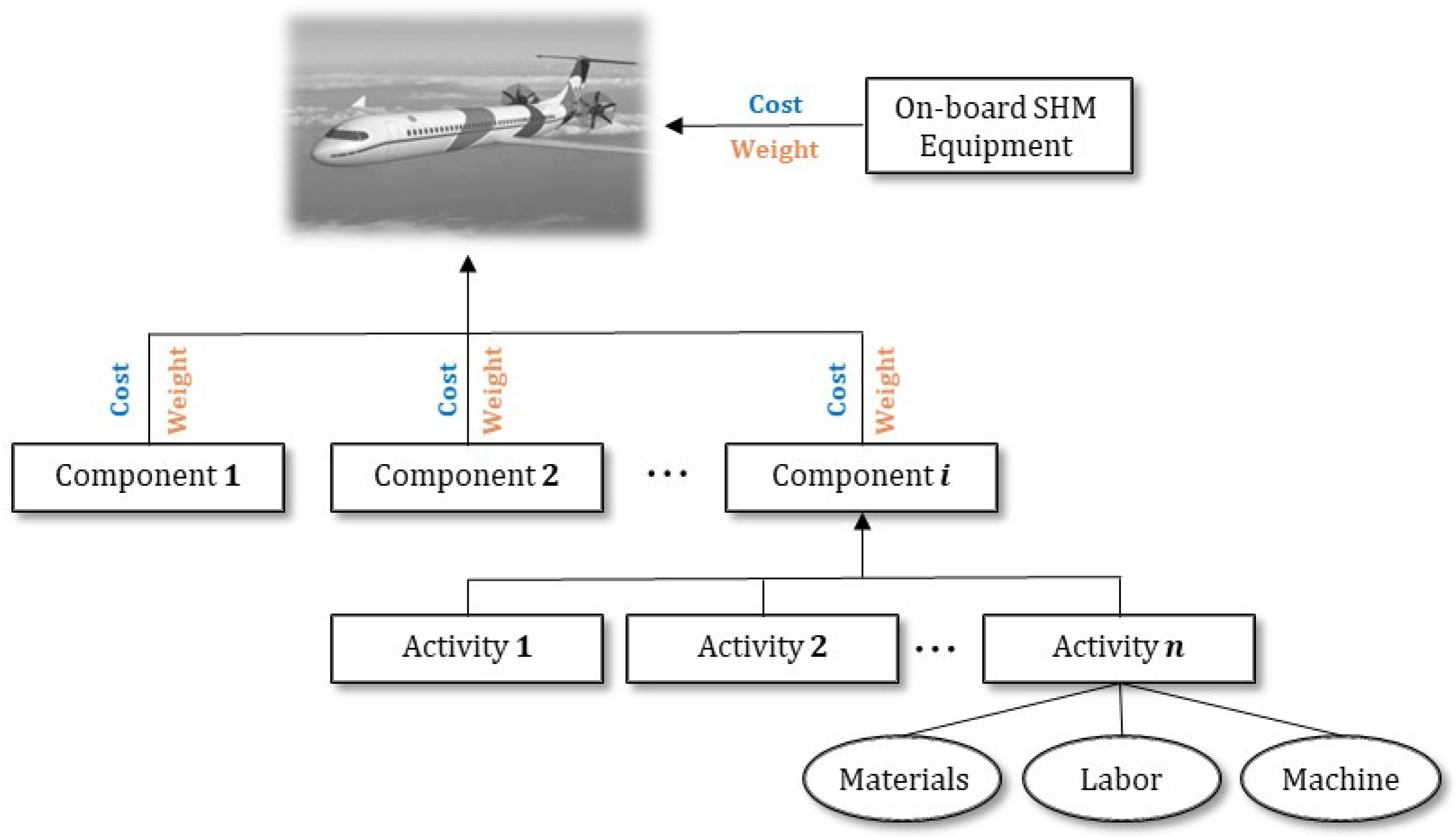

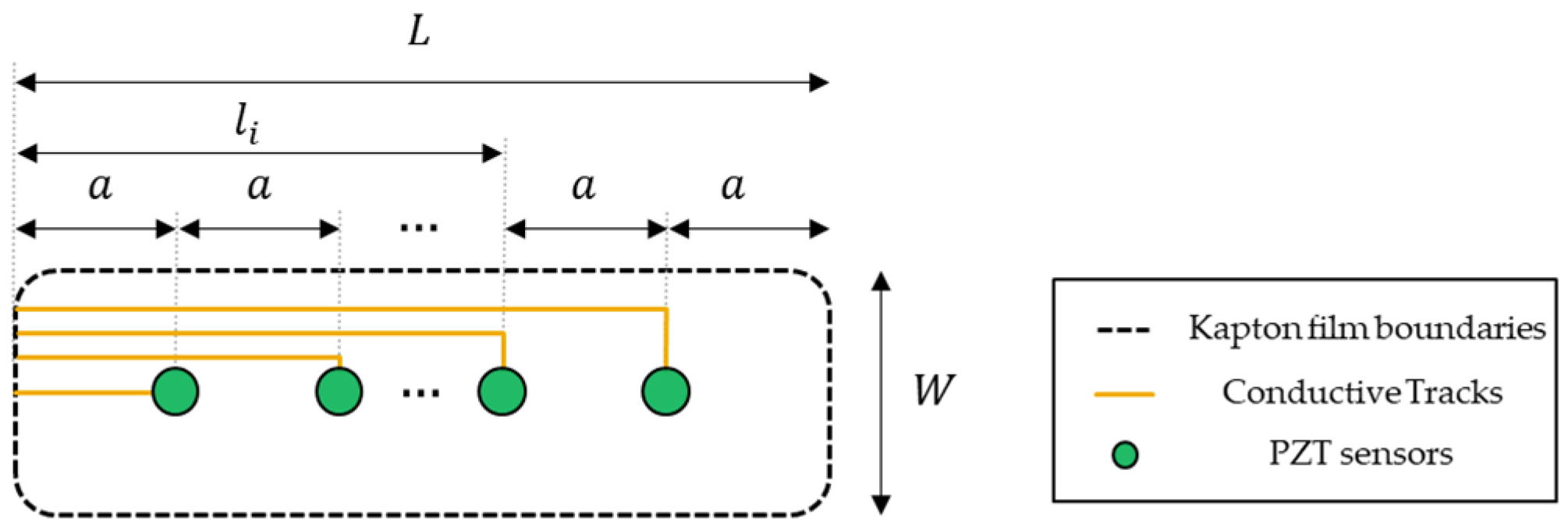
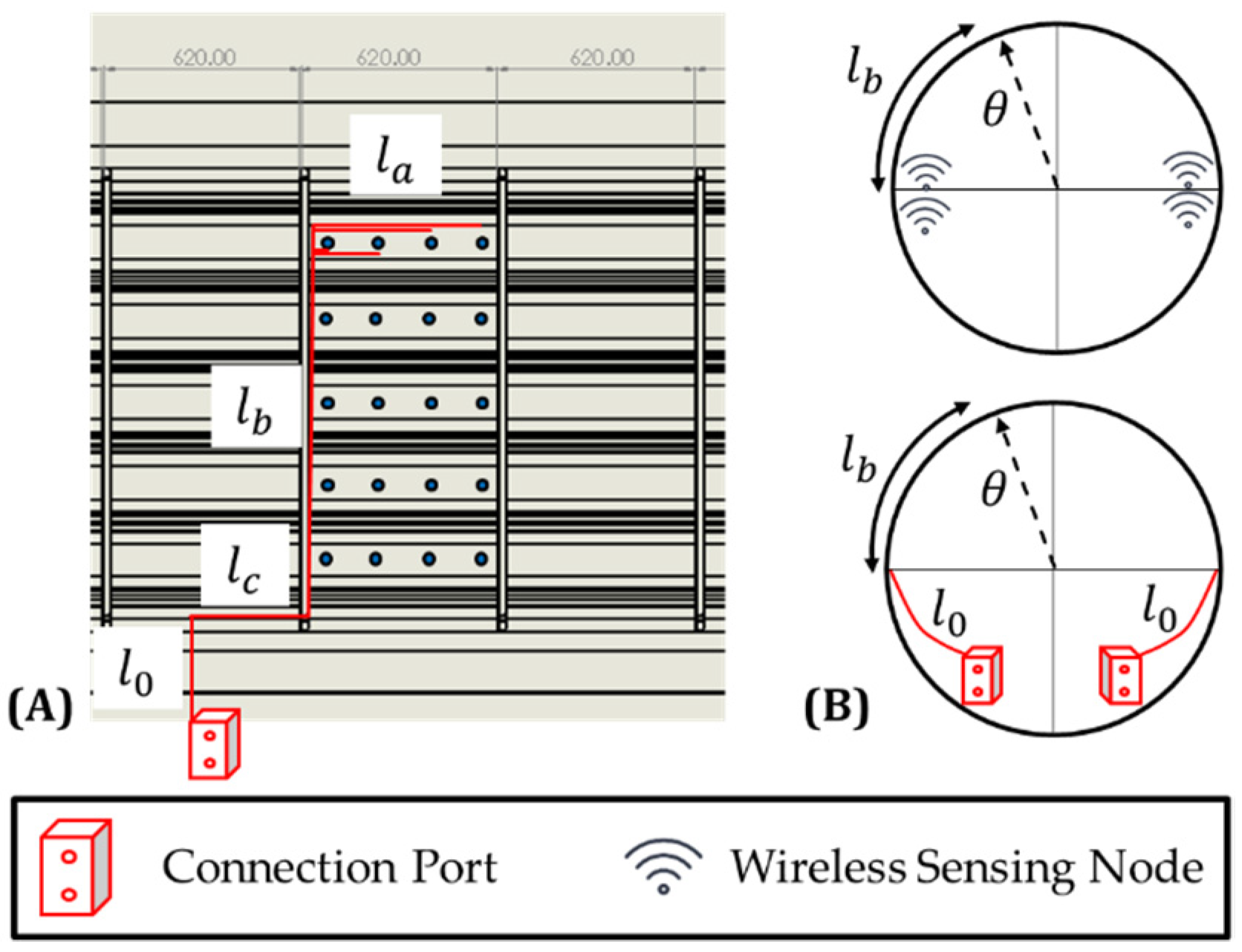
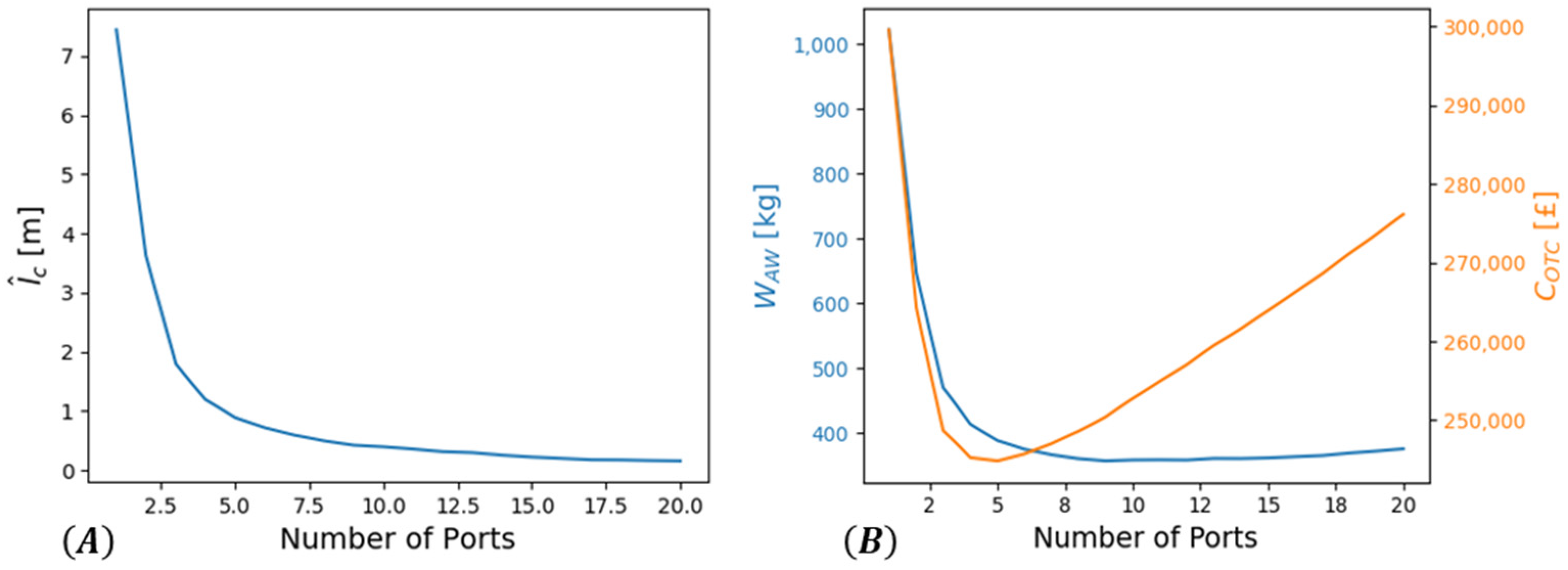
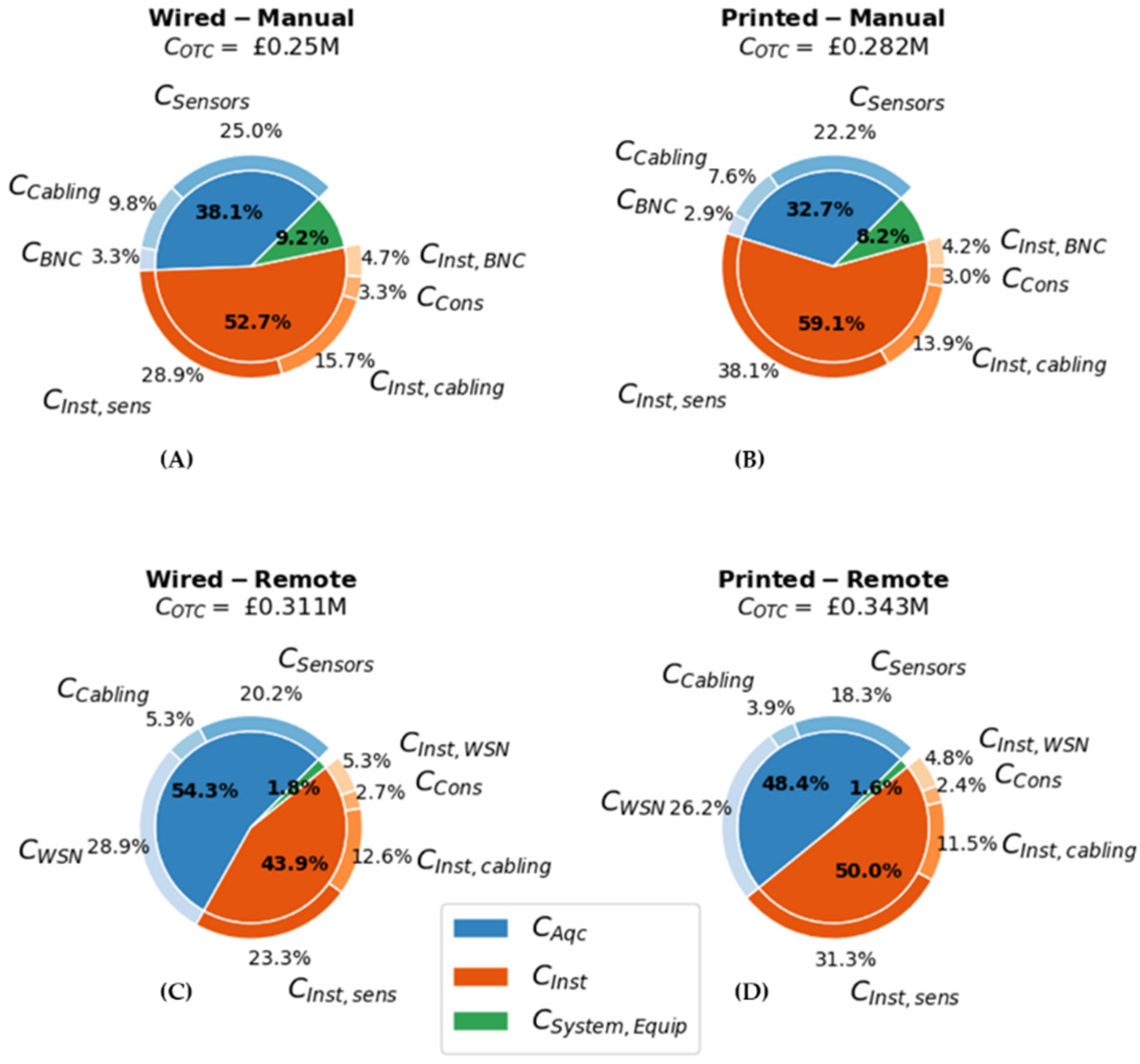

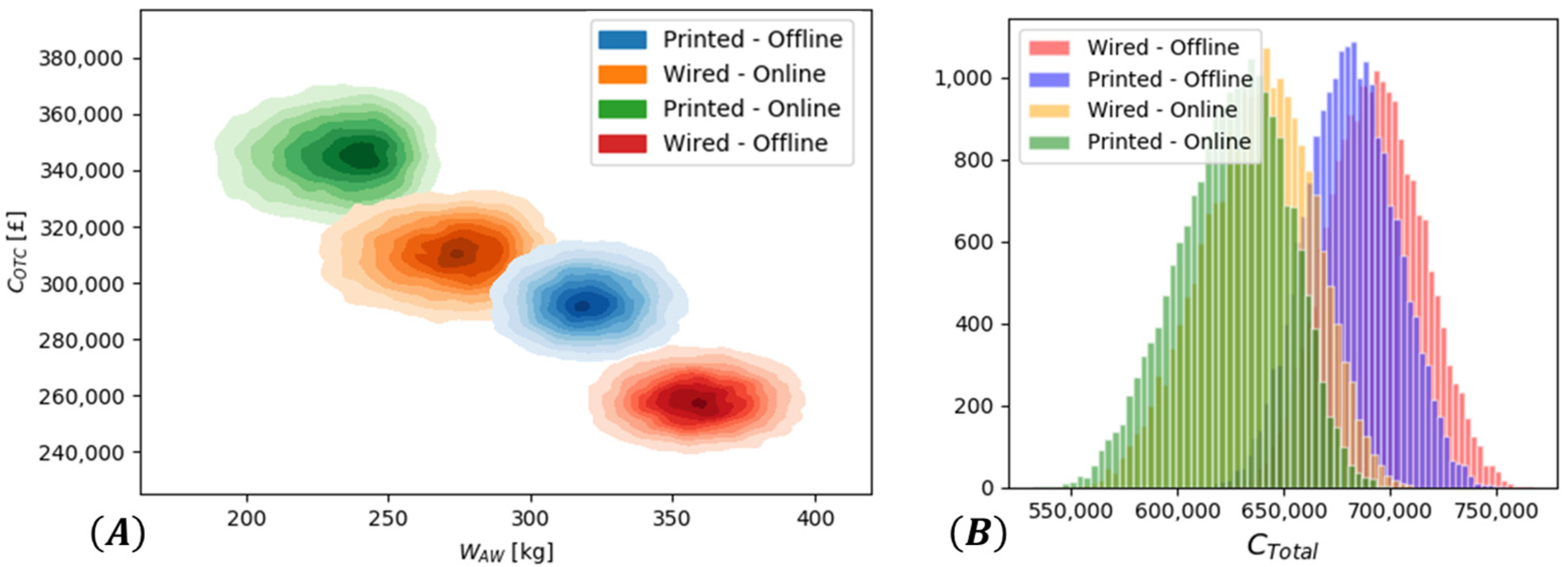
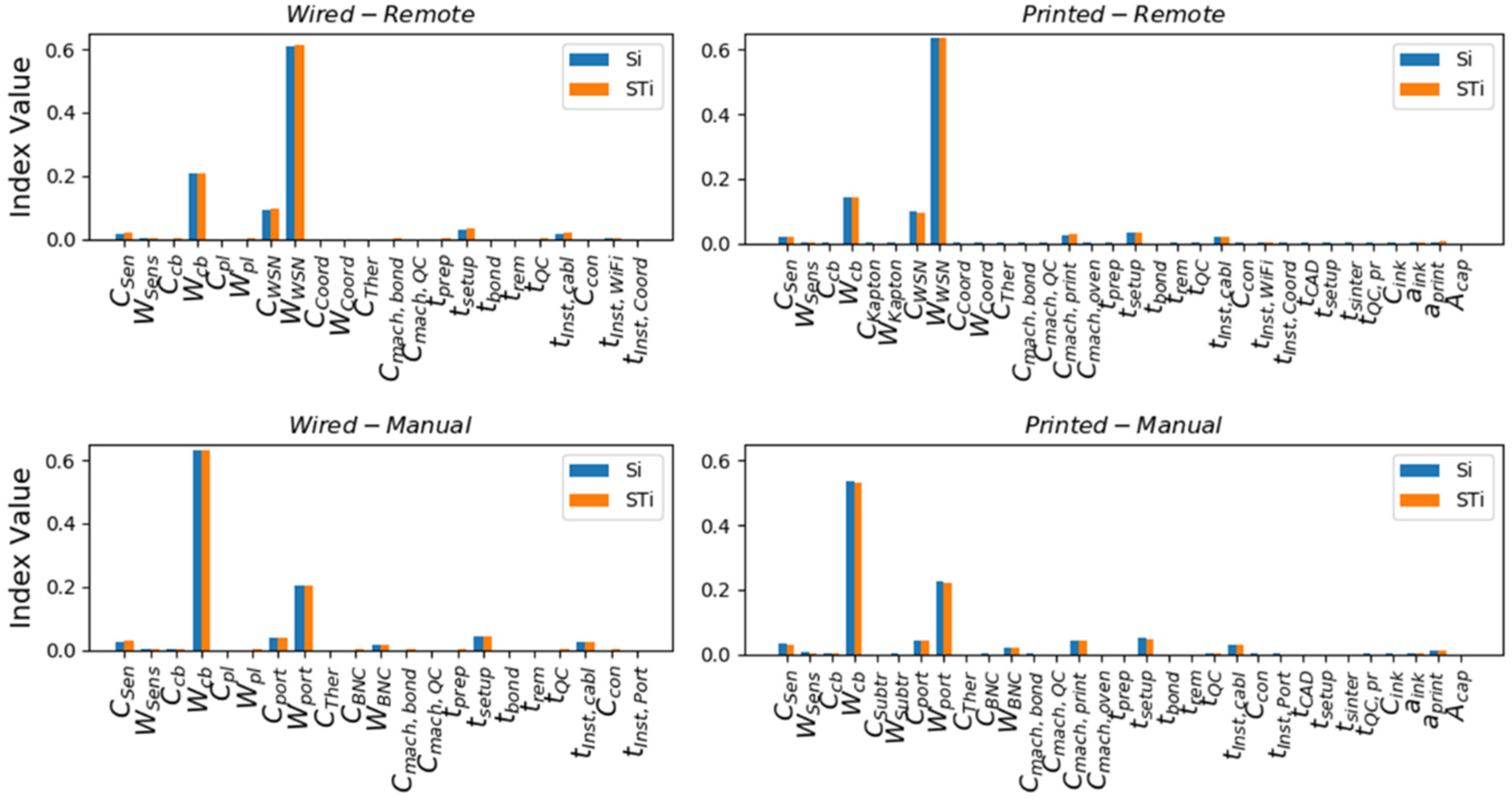
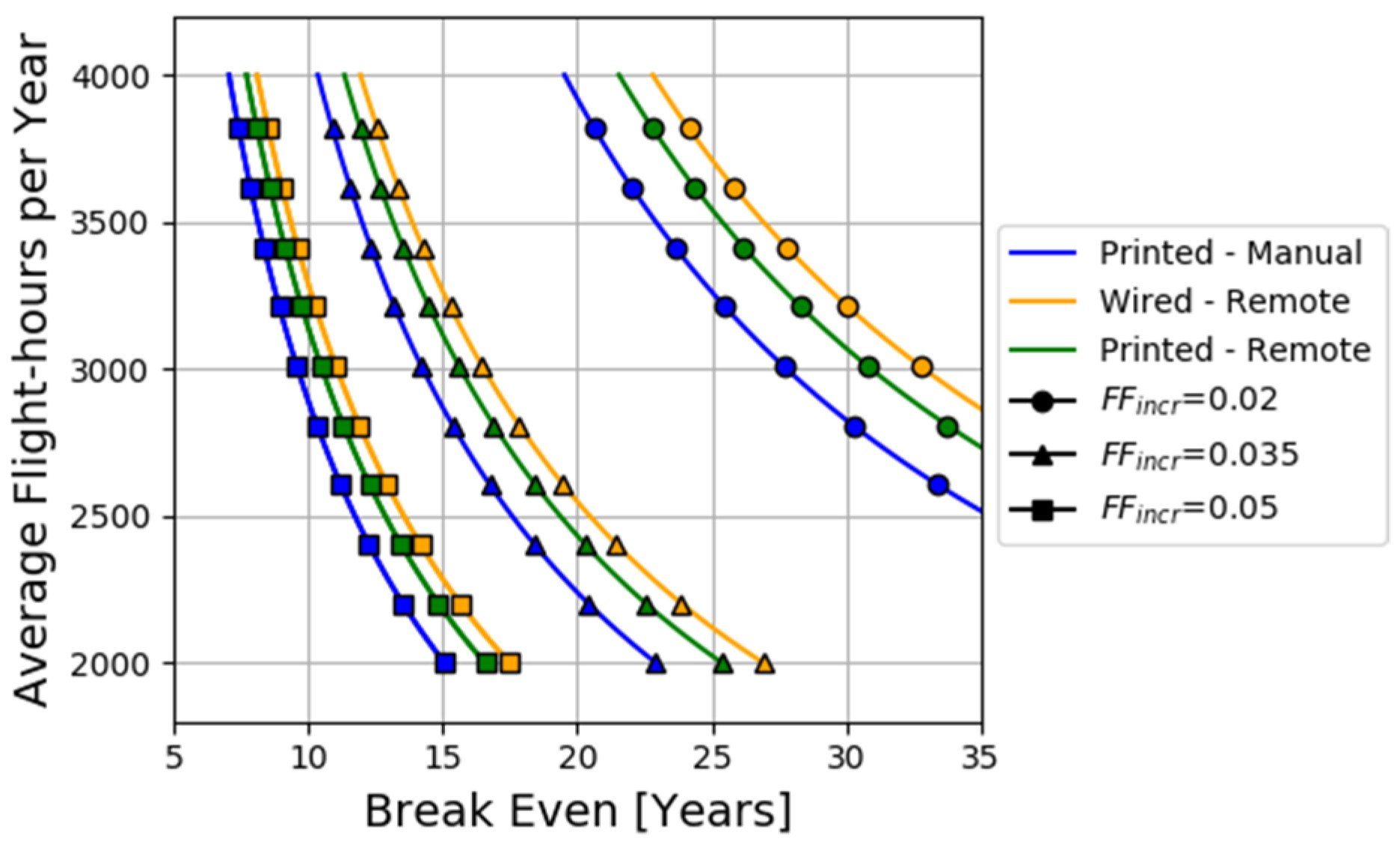
| Variable | Description | Units | Value |
|---|---|---|---|
| Fuselage Length | |||
| Fuselage Diameter | |||
| Bay Length | |||
| Bay Arc Length | |||
| Batch Area | 0.093 | ||
| Labour Rate | 95 | ||
| Number of Sensors per Bay |
| SHM Costs and Weights | |||||
|---|---|---|---|---|---|
| Variable | Description | Units | Lower | Expected | Upper |
| DuraAct Sensor Cost | 45 | 50 | 55 | ||
| DuraAct Sensor Weight | 0.0045 | 0.005 | 0.0055 | ||
| Coaxial Cable Cost | 1.8 | 2 | 2.2 | ||
| Coaxial Cable Weight | 0.018 | 0.02 | 0.022 | ||
| BNC Connector Cost | 1.8 | 2 | 2.2 | ||
| BNC Connector Weight | 0.009 | 0.01 | 0.011 | ||
| Kapton film Cost | 33.3 | 37 | 40.7 | ||
| Kapton film Weight | 0.045 | 0.05 | 0.055 | ||
| Protective layer Cost | 0.9 | 1 | 1.1 | ||
| Protective layer Weight | 0.135 | 0.15 | 0.0165 | ||
| Connection Port Cost | 700 | 1000 | 1500 | ||
| Connection Port Weight | 1.5 | 2 | 3 | ||
| WSN Node Cost | 400 | 500 | 550 | ||
| WSN Node Weight | 0.25 | 0.5 | 0.55 | ||
| Network Coordinator Cost | 4500 | 5000 | 5500 | ||
| Network Coordinator Weight | 4.5 | 5 | 5.5 | ||
| Thermoplastic Film Cost | 18 | 20 | 22 | ||
| SHM System Installation | |||||
| Variable | Description | Units | Lower | Expected | Upper |
| Surface preparation | 0.018 | 0.02 | 0.024 | ||
| Set-up for the sensor bonding | 0.45 | 0.5 | 0.6 | ||
| Curing duration | 0.5 | 0.5 | 0.55 | ||
| Removal of failed sensors | 0.045 | 0.05 | 0.06 | ||
| QC check duration | 0.018 | 0.02 | 0.024 | ||
| Cabling installation | 0.09 | 0.1 | 0.12 | ||
| Connection port installation | 2.7 | 3 | 3.6 | ||
| WSN node installation | 0.9 | 1 | 1.2 | ||
| Coordinator installation | 4.5 | 5 | 6 | ||
| Installation consumables | 1.8 | 2 | 2.2 | ||
| Bonding failure rate | 0.01 | ||||
| Printing Information | |||||
| Variable | Description | Units | Lower | Expected | Upper |
| CAD Geometry preparation | 2.7 | 3 | 3.3 | ||
| Ink-jet printer setup | 0.9 | 1 | 1.2 | ||
| Sintering duration | 0.5 | 0.5 | 0.6 | ||
| QC check duration | h | 0.045 | 0.05 | 0.06 | |
| Silver Particle Ink | 21.15 | 23.5 | 25.85 | ||
| Ink use rate | 0.36 | 0.4 | 0.48 | ||
| Print Speed | 1 | 1.25 | 1.375 | ||
| Oven Capacity | 0.9 | 1 | 1.2 | ||
| Printing failure rate | 0.01 | ||||
| Machine Use Costs | |||||
| Variable | Description | Units | Lower | Expected | Upper |
| Bonding Equipment cost | 4 | 5 | 8 | ||
| Printer use cost | 15 | 20 | 30 | ||
| Sintering oven use cost | 18 | 20 | 22 | ||
| QC equipment use cost | 4 | 5 | 8 | ||
Publisher’s Note: MDPI stays neutral with regard to jurisdictional claims in published maps and institutional affiliations. |
© 2022 by the authors. Licensee MDPI, Basel, Switzerland. This article is an open access article distributed under the terms and conditions of the Creative Commons Attribution (CC BY) license (https://creativecommons.org/licenses/by/4.0/).
Share and Cite
Giannakeas, I.N.; Khodaei, Z.S.; Aliabadi, M.H.F. Structural Health Monitoring Cost Estimation of a Piezosensorized Aircraft Fuselage. Sensors 2022, 22, 1771. https://doi.org/10.3390/s22051771
Giannakeas IN, Khodaei ZS, Aliabadi MHF. Structural Health Monitoring Cost Estimation of a Piezosensorized Aircraft Fuselage. Sensors. 2022; 22(5):1771. https://doi.org/10.3390/s22051771
Chicago/Turabian StyleGiannakeas, Ilias N., Zahra Sharif Khodaei, and M. H. Ferri Aliabadi. 2022. "Structural Health Monitoring Cost Estimation of a Piezosensorized Aircraft Fuselage" Sensors 22, no. 5: 1771. https://doi.org/10.3390/s22051771
APA StyleGiannakeas, I. N., Khodaei, Z. S., & Aliabadi, M. H. F. (2022). Structural Health Monitoring Cost Estimation of a Piezosensorized Aircraft Fuselage. Sensors, 22(5), 1771. https://doi.org/10.3390/s22051771







